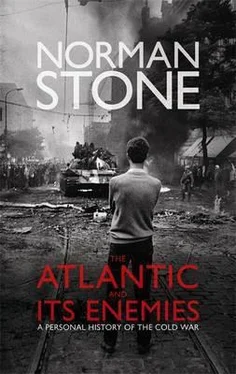Meanwhile vulnerability assessments of the Soviet economy were prophetic, convincing Casey (and Reagan) that the economy, dependent on the West for machinery to exploit the raw materials, was indeed about to implode and besides, as the terms of trade worsened, the OPEC countries would have less money with which to buy Soviet weaponry. In the 1970s Soviet earnings had risen 272 per cent, whereas oil exports had risen only by a fifth. Herbert E. Meyer, Casey’s chief banking and energy adviser, reckoned that each dollar in the price of oil meant a thousand million for Moscow. It was clear that both a British company, John Brown Engineering, and the French firm wanted to take over the supply of turbines for the Siberian gas pipeline project, and Casey could point to the $15-20bn per annum that would accrue. There was an important Chinese dimension to all of this. The Chinese took over from the Iranians as watchers of Soviet missiles; they supplied Soviet equipment to the resistance in Afghanistan; they maintained a Radio Urumchi for Central Asia. The Americans relaxed CoCom for them, the multilateral agreement to limit the export of the most advanced technology. On 23 March 1983 Reagan made his Star Wars speech — he would exploit Soviet weakness in the new generation of electronics. CoCom was tightened up, and 1,400 illegal shipments of high-tech equipment were seized (to 1987). Another wheeze was for dummy companies to sell fake technology such as flawed blueprints for gas turbines. Meanwhile the US was doing twice as much defence procurement as in the 1970s — 10,000 tanks and 3,700 strategic missiles. In 1984 Weinberger was aggressive at NATO in Brussels, as there always was a US component in the advanced technological items: that was one basis of the American recovery. The Pentagon budget for research and development had doubled and the Soviet defence budget was supposed to have risen by 45 per cent as well, to take account of proton beams. Gromyko accused Reagan to his face of using Poland as a lever and of trying to ‘exhaust’ the USSR into ‘surrender’.
Meanwhile oil prices went down. Twenty dollars per barrel was regarded as the right price for the USA, whereas in 1983 $34 prevailed. US energy imports would drop from $183bn to $70bn, or 1 per cent of GNP, as these imports (5.5 million barrels) accounted for a quarter of all. The Saudis took only $1.50 to produce a barrel, and Fahd visited Reagan early in 1985. The basic calculation was that a drop in the price of $5 would raise the American GNP by 1.4 per cent, bring down the deficit and reduce inflation. In effect the Saudis financed the Contras in Nicaragua. They then had to double output and agreed to do so; Nigel Lawson also wanted this, and the USA, by running down her own stock (held in salt caves in Texas), could drastically cut prices at will. The British did cut prices to $30, and OPEC went below that in 1983. The Soviets responded by sending Haydar Aliev in his English suits and Italian shoes to see Hafiz Assad, who had cut the Iraq-Syria pipeline in order to help Iran; the Saudis feared Iran and wanted Stingers and AWACS. The Saudis also worried that natural gas was replacing oil (1984). There were by now 1,700 US troops in Saudi Arabia, and the AWACS arrived; it was the same deal as with the Germans in the 1970s — support for the dollar in return for defence. Casey told the Saudis in advance that there would be a 25 per cent devaluation of the dollar in 1985 (the Plaza Agreement) and they acquired non-dollar assets to offset the fall in the oil price. Through Edgar Bronfman of Seagram (cover for the CIA) Casey had another channel towards Israel, which required reassurance as to the help for the Saudis. In August 1985 the Saudis started raising their output from 2 million to 6 million barrels and then 9 million such that prices fell to $12 by June 1986, a loss to Moscow of $1.4bn. Bush — a Texas oilman — did not like all of this and there were rows with Reagan. But by 1986 it took five times as much Soviet oil for a given piece of German machinery.
Meanwhile the Afghan crisis mounted. The CIA shipped its weapons and tried to keep President Muhammad Zia-ul-Haq clean, but the Soviets responded with bazaar bombs and drove refugees into Pakistan with a view to destabilization. William Casey expressly said that this was America’s revenge for Vietnam. Bagram airbase was attacked by the mujaheddin, and twenty aircraft were destroyed by Chinese-supplied rocket-launchers; several senior Soviet officials and military were killed in Kabul. In January 1985 Soviet plans were known in advance (use of Spetsnaz night attacks with a van to interrupt mujaheddin communications). NSDD-166 of March 1985 was intended to end the stalemate and was to allow serious weaponry and not just the Carter harassment idea. There were 120,000 Soviet troops in Afghanistan in 1985 but the mujaheddin had night-vision and precision-guided weapons as well as satellite intelligence, and even a device to identify a pilot’s voice as belonging to a particular unit. The oil pipelines were sabotaged; Kandahar airport attacked; Najibullah nearly murdered; 450 prisoners taken by Ahmad Shah Massoud (‘Lion of the Panshir’). By 1985, from Oleg Gordievsky (who defected in 1986) and other sources the encouraging news came back that the Siberian pipeline had been cut in half and was two years behind schedule in construction; the turbines were inadequate. Then the Stingers arrived, in July 1986: a ‘fire and forget’ weapon, meaning that the aimer could fire and then not remain exposed to counterfire. The missile could go up to 15,000 feet at 1,200 miles per hour. The mujaheddin first used it on 25 September 1986 and there were two strikes near Jalalabad airfield, and further ones over Tadzhikistan. In December 1986 Gorbachev told Najibullah in Moscow that there would have to be a withdrawal. His own Central Asian territories began to rumble, as in Alma Ata a rampage followed the fall of Dinmukhamed Kunayev and his replacement as boss of the Party by a Russian.
Gorbachev, in the first two years, talked. He talked and talked. Generally, what he said was long-winded and even impossible to unravel; the book that he subsequently produced launched a word, perestroyka or ‘reconstruction’, which entered the world’s vocabulary along with Sputnik and gulag as the Soviet contribution. So did another, glasnost , meaning ‘openness to criticism’. This was supposed to be revolutionary but in practice it was quite old. Ever since the early days, under Lenin, Bolsheviks had been well and truly aware that all was not well, that bureaucracy was somehow getting in the way of the original spirit, and calls for perestroyka had been made in the 1920s, sometimes by someone ambitious for the leadership. That criticism was suppressed — the intelligentsia muzzled, imprisoned or worse — made the problem worse, and glasnost was again quite an old cry. In effect all that was being done, in the first two years, was consolidation of Gorbachev’s position and the establishment of his coterie of ambitious advisers. The principal change was in foreign affairs, where a new approach was made to the Western Right, with a view to some dramatic arrangement as to arms control and a diminution of Western support for the Afghan rebels. There were other obstacles, such as CoCom, which did not stop the export, but made it expensive. And in any case the Western Left, especially the German, had proved to be of very limited utility; it was even being dropped by Moscow before Gorbachev himself emerged. At any rate there was a new era in relations, because, quite suddenly, Soviet representatives turned out to be agreeable drinking companions, quite willing to talk freely. This made, already, a huge change with the past and a great number of journalists, used to the restrictions of earlier years, allowed a natural Russophilia to emerge. It was a tribute at least to the public relations machinery in Moscow, which had been very wooden for a generation and was now learning fast. But in the first two years, and for that matter throughout Gorbachev’s six years in office, perestroyka remained a matter of words. The powers that be ranted on about the virtues of central planning, and amalgamated five huge ministries dealing with agriculture into one very huge ministry, which spewed out regulations to the collective farms even more frenetically than in Khrushchev’s time, and was not heard of within a year or so. Investment in heavy industries went up, the economist arguing for this, one Abel Aganbegyan, himself rollingly mountainous, being sent abroad to explain that there was new thinking in matters economic. Though gushed over by naïve Russian-speaking females at Oxford, he did not take in Margaret Thatcher, who knew her economics.
Читать дальше












![Edward Ellis - Adrift on the Pacific - A Boys [sic] Story of the Sea and its Perils](/books/753342/edward-ellis-adrift-on-the-pacific-a-boys-sic-s-thumb.webp)